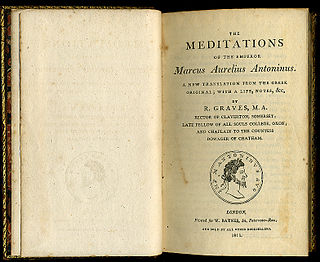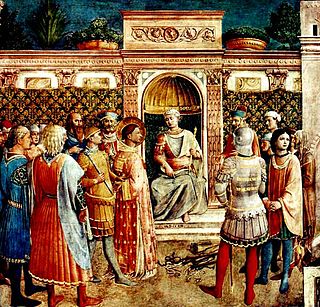
Epictetus was a Greek Stoic philosopher. He was born into slavery at Hierapolis, Phrygia and lived in Rome until his banishment, when he went to Nicopolis in northwestern Greece, where he spent the rest of his life. His teachings were written down and published by his pupil Arrian in his Discourses and Enchiridion.

Marcus Aurelius Antoninus was Roman emperor from 161 to 180 and a Stoic philosopher. He was a member of the Nerva–Antonine dynasty, the last of the rulers later known as the Five Good Emperors and the last emperor of the Pax Romana, an age of relative peace, calm, and stability for the Roman Empire lasting from 27 BC to 180 AD. He served as Roman consul in 140, 145, and 161.
In philosophy, euthymia is, according to the ancient Greek philosopher Democritus, a basis of human life goals.

Meditations is a series of personal writings by Marcus Aurelius, Roman Emperor from AD 161 to 180, recording his private notes to himself and ideas on Stoic philosophy.
Ancient Roman philosophy is philosophy as it was practiced in the Roman Republic and its successor state, the Roman Empire. Roman philosophy includes not only philosophy written in Latin, but also philosophy written in Greek in the late Republic and Roman Empire. Important early Latin-language writers include Lucretius, Cicero, and Seneca the Younger. Greek was a popular language for writing about philosophy, so much so that the Roman Emperor Marcus Aurelius chose to write his Meditations in Greek.

The Epistulae Morales ad Lucilium, also known as the Moral Epistles and Letters from a Stoic, is a letter collection of 124 letters that Seneca the Younger wrote at the end of his life, during his retirement, after he had worked for the Emperor Nero for more than ten years. They are addressed to Lucilius Junior, the then procurator of Sicily, who is known only through Seneca's writings. Regardless of how Seneca and Lucilius actually corresponded, it is clear that Seneca crafted the letters with a broad readership in mind.
Amor fati is a Latin phrase that may be translated as "love of fate" or "love of one's fate". It is used to describe an attitude in which one sees everything that happens in one's life, including suffering and loss, as good or, at the very least, necessary.
Neostoicism was a philosophical movement that arose in the late 16th century from the works of Justus Lipsius, and sought to combine the beliefs of Stoicism and Christianity. Lipsius was Flemish and a Renaissance humanist. The movement took on the nature of religious syncretism, although modern scholarship does not consider that it resulted in a successful synthesis. The name "neostoicism" is attributed to two Roman Catholic authors, Léontine Zanta and Julien-Eymard d'Angers.

A Calendar of Wisdom, also known as Path of life, A Cycle of Readings or Wise Thoughts for Every Day, is a collection of insights and wisdom compiled by Leo Tolstoy between 1903 and 1911 that was published in three different editions. An English translation by Archibald J. Wolfe of the first Russian edition, which was organized by subject, was published in 1919. An English translation of the second Russian edition, which was organized by calendar date, was begun in 1911 as a monthly serial but abandoned after the first volume. The first translation of the entire yearly cycle, but which omitted some of the individual readings, was made by Peter Sekirin and published in 1997. The book, whose title is literally translated as Circle of Reading, was described by Tolstoy as "a wise thought for every day of the year, from the great philosophers of all times and all people" which he himself would consult daily for the rest of his life. Teachings from historical figures including Epictetus, Marcus Aurelius, Lao-Tzu, Buddha, Pascal, Jesus, Muhammad, Confucius, Emerson, Kant, Ruskin, Seneca, Socrates, Thoreau prompted Tolstoy to write in the introduction, "I hope that the readers of this book may experience the same benevolent and elevating feeling which I have experienced when I was working on its creation, and which I experience again and again when I reread it every day, working on the enlargement and improvement of the previous edition."

Quintus Junius Rusticus, was a Roman teacher and politician. He was probably a grandson of Arulenus Rusticus, who was a prominent member of the Stoic Opposition. He was a Stoic philosopher and was one of the teachers of the emperor Marcus Aurelius, whom Aurelius treated with the utmost respect and honour.
Paconius Agrippinus was a Stoic philosopher of the 1st century. His father was put to death by the Roman emperor Tiberius on a charge of treason. Agrippinus himself was accused at the same time as Thrasea, around 67 AD, and was banished from Italy. As a philosopher he was spoken of with praise by Epictetus.

Stoicism is a school of Hellenistic philosophy that flourished in Ancient Greece and Ancient Rome. The Stoics believed that the practice of virtue is enough to achieve eudaimonia: a well-lived life. The Stoics identified the path to achieving it with a life spent practicing the four virtues in everyday life: wisdom, courage, temperance or moderation, and justice, and living in accordance with nature. It was founded in the ancient Agora of Athens by Zeno of Citium around 300 BC.
A sage, in classical philosophy, is someone who has attained wisdom. The term has also been used interchangeably with a 'good person', and a 'virtuous person'. Among the earliest accounts of the sage begin with Empedocles' Sphairos. Horace describes the Sphairos as "Completely within itself, well-rounded and spherical, so that nothing extraneous can adhere to it, because of its smooth and polished surface." Alternatively, the sage is one who lives "according to an ideal which transcends the everyday."

The early life of Marcus Aurelius spans the time from his birth on 26 April 121 until his accession as Roman emperor on 8 March 161.

Ryan Holiday is an American marketer, author, businessman and podcaster, notable for marketing Stoic philosophy in the form of books.

Trust Me, I'm Lying: Confessions of a Media Manipulator is a book by Ryan Holiday chronicling his time working as a media strategist for clients including Tucker Max, Robert Greene, and Dov Charney.
William O. Stephens, is an American philosopher and scholar of Stoicism. He is Professor Emeritus of Philosophy at Creighton University after retiring from teaching at their Omaha Campus in 2020.

Brendon Burchard is an author, high performance coach and motivational speaker.

The Stoic Opposition is the name given to a group of Stoic philosophers who actively opposed the autocratic rule of certain emperors in the 1st-century, particularly Nero and Domitian. Most prominent among them was Thrasea Paetus, an influential Roman senator executed by Nero. They were held in high regard by the later Stoics Epictetus and Marcus Aurelius. Thrasea, Rubellius Plautus and Barea Soranus were reputedly students of the famous Stoic teacher Musonius Rufus and as all three were executed by Nero they became known collectively as the Stoic martyrs.
Negative visualization or futurorum malorum præmeditatio is a method of meditative praxis or askēsis by visualization of the worst-case scenario(s). The method originated with the Cyreanic philosophers and was later adopted by Stoic philosophers. The technique was made popular with publications of Seneca the Younger's Epistulae Morales ad Lucilium. It is thought to have been one of the common forms of Stoic spiritual exercises.












